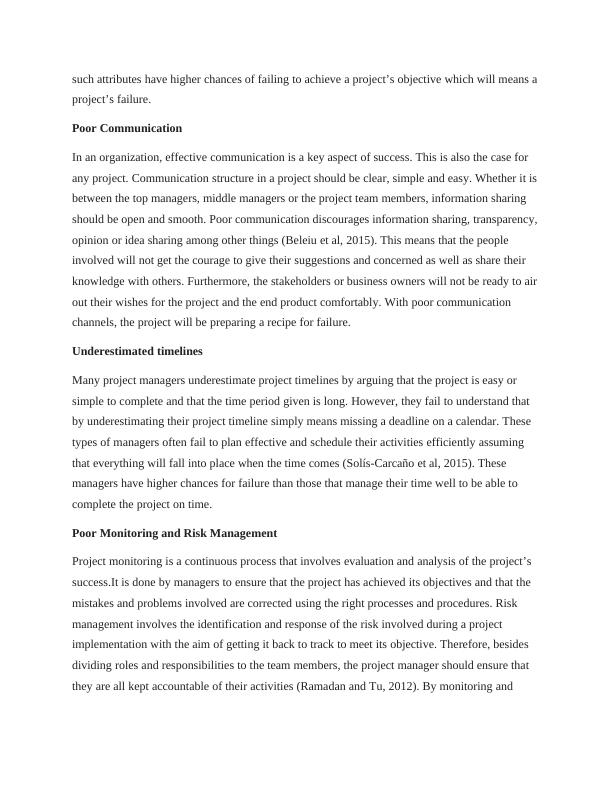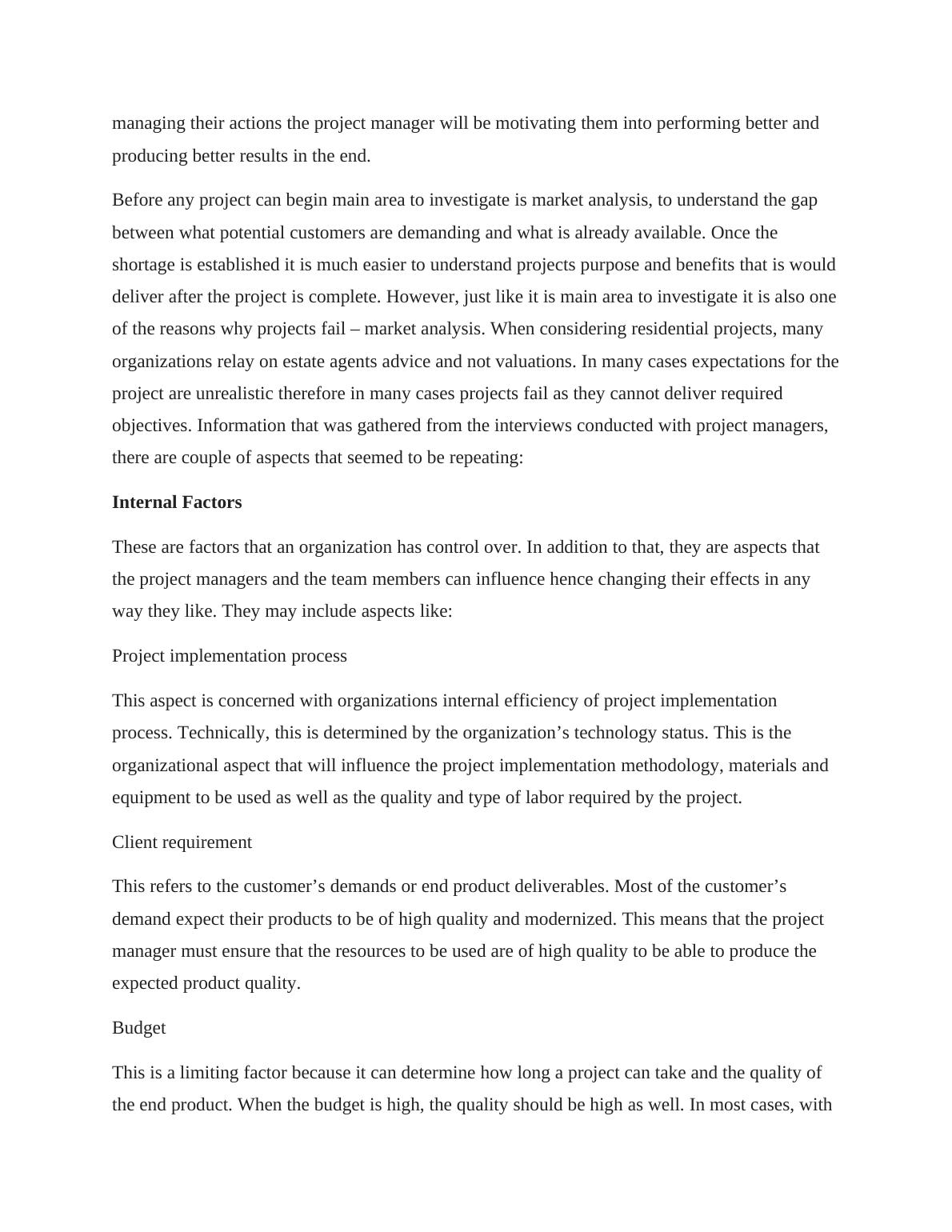The Project Management Analysis | Study
11 Pages4068 Words52 Views
Added on 2020-04-01
The Project Management Analysis | Study
Added on 2020-04-01
ShareRelated Documents
NAMESTUDENT IDSUBJECTTOPICDATE

PPROJECT MANAGEMENT ANALYSISIn most cases, project managers would assume that their projects would be delivered on time andon budget, unfortunately in reality statistics tell different story. Therefore is the project is delivered on time and within agreed budget it does not mean that the project did not fail. When project is finished, it is important to ask ‘Did the project deliver benefits, quality and results that were expected?’ If project was successful can only be determined after project delivers benefits itwas supposed to. The following factors are not the only ones that affect the success or failure of a project, but in this research, they appear the most. Lack of visibility of the project. All levels ofproject team (executive management, project managers, and team members) need visibility of theright information at all times. Using multiple tools for information like emails, PM software, and spreadsheets means that the information is always floating around and it is not visible to the all project team. As identified by project managers scattered information is a set towards disaster. All projects differ from one to another, therefore reasons why they fail are different as well. However there are factors that appear to be common when it comes to project failure, they include some the following:Poor preparation or planningBefore every project is begun, the project manager must ensure that they have a clear picture of what they are supposed/going to do in advance. This includes ensuring that that all the resources and project deliverable are all available, enough and functional (Haughey, 2014). In addition to that, they should be sure of the stakeholder’s expectations, project scope, time period, budget andthe product quality. Poor preparation is contributed by lack of proper activity scheduling, poor timing, failure to divide roles and responsibilities at all/as early as possible among other things (Nassa and Yadav, 2012). Without proper preparation, the project manager and the team members may find themselves loosing track of the project’s progress and focus.Poor leadershipA project’s leader is always the project manager. Poor leadership can be contributed by aspects like project manager’s lack of experience, lack of effective skills in leadership or management, incompetency among other things (Garbharran et al, 2012). These are some of the aspects that every manager should have to be able to succeed in their management role. Managers lacking

such attributes have higher chances of failing to achieve a project’s objective which will means aproject’s failure.Poor CommunicationIn an organization, effective communication is a key aspect of success. This is also the case for any project. Communication structure in a project should be clear, simple and easy. Whether it isbetween the top managers, middle managers or the project team members, information sharing should be open and smooth. Poor communication discourages information sharing, transparency,opinion or idea sharing among other things (Beleiu et al, 2015). This means that the people involved will not get the courage to give their suggestions and concerned as well as share their knowledge with others. Furthermore, the stakeholders or business owners will not be ready to airout their wishes for the project and the end product comfortably. With poor communication channels, the project will be preparing a recipe for failure.Underestimated timelinesMany project managers underestimate project timelines by arguing that the project is easy or simple to complete and that the time period given is long. However, they fail to understand that by underestimating their project timeline simply means missing a deadline on a calendar. These types of managers often fail to plan effective and schedule their activities efficiently assuming that everything will fall into place when the time comes (Solís-Carcaño et al, 2015). These managers have higher chances for failure than those that manage their time well to be able to complete the project on time.Poor Monitoring and Risk ManagementProject monitoring is a continuous process that involves evaluation and analysis of the project’s success.It is done by managers to ensure that the project has achieved its objectives and that the mistakes and problems involved are corrected using the right processes and procedures. Risk management involves the identification and response of the risk involved during a project implementation with the aim of getting it back to track to meet its objective. Therefore, besides dividing roles and responsibilities to the team members, the project manager should ensure that they are all kept accountable of their activities (Ramadan and Tu, 2012). By monitoring and

managing their actions the project manager will be motivating them into performing better and producing better results in the end.Before any project can begin main area to investigate is market analysis, to understand the gap between what potential customers are demanding and what is already available. Once the shortage is established it is much easier to understand projects purpose and benefits that is woulddeliver after the project is complete. However, just like it is main area to investigate it is also oneof the reasons why projects fail – market analysis. When considering residential projects, many organizations relay on estate agents advice and not valuations. In many cases expectations for theproject are unrealistic therefore in many cases projects fail as they cannot deliver required objectives. Information that was gathered from the interviews conducted with project managers, there are couple of aspects that seemed to be repeating:Internal FactorsThese are factors that an organization has control over. In addition to that, they are aspects that the project managers and the team members can influence hence changing their effects in any way they like. They may include aspects like:Project implementation processThis aspect is concerned with organizations internal efficiency of project implementation process. Technically, this is determined by the organization’s technology status. This is the organizational aspect that will influence the project implementation methodology, materials and equipment to be used as well as the quality and type of labor required by the project.Client requirementThis refers to the customer’s demands or end product deliverables. Most of the customer’s demand expect their products to be of high quality and modernized. This means that the project manager must ensure that the resources to be used are of high quality to be able to produce the expected product quality.BudgetThis is a limiting factor because it can determine how long a project can take and the quality of the end product. When the budget is high, the quality should be high as well. In most cases, with

End of preview
Want to access all the pages? Upload your documents or become a member.
Related Documents
Why do projects go wrong? | Skills required of a Project Managerlg...
|5
|1842
|59
Project Management - Importance of Communication, Virtual Teams, Global Teams and Benefits of Going Internationallg...
|6
|1431
|436
Program and Portfolio Management Information Systemlg...
|13
|3163
|223
Project Scheduling and Time Managementlg...
|10
|2492
|95
Project Analysis: Wembley Stadium and Berlin Brandenburg Airportlg...
|4
|895
|100
Importance of Effective Communication in Project Managementlg...
|8
|2252
|286
